HONDA ELEMENT 2005 1.G Owners Manual
Manufacturer: HONDA, Model Year: 2005, Model line: ELEMENT, Model: HONDA ELEMENT 2005 1.GPages: 249, PDF Size: 3.26 MB
Page 181 of 249
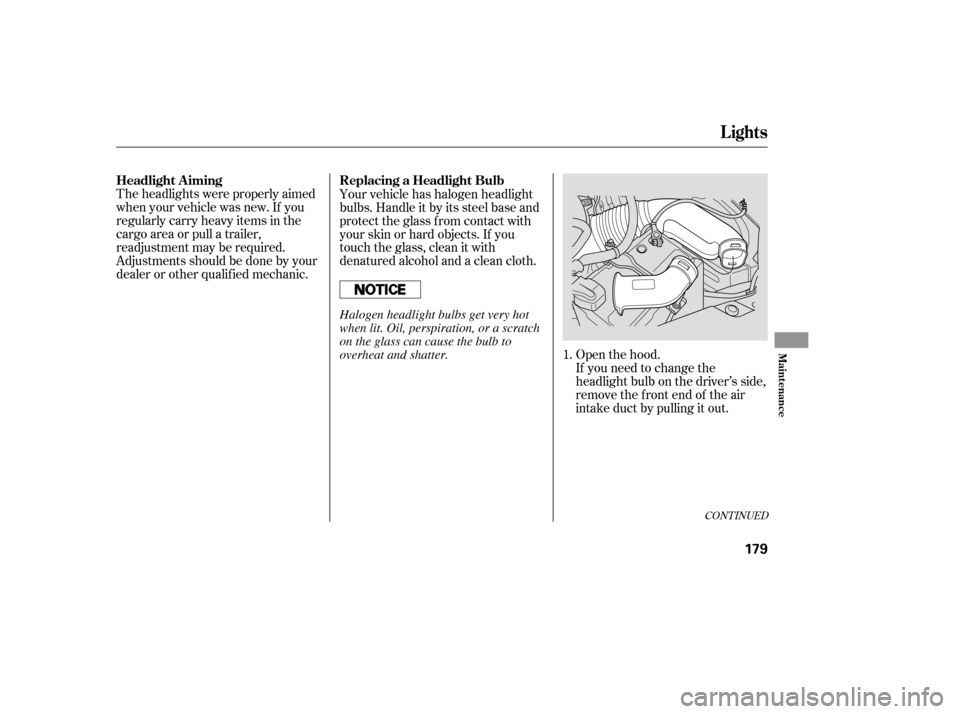
Theheadlightswereproperlyaimed
when your vehicle was new. If you
regularly carry heavy items in the
cargo area or pull a trailer,
readjustment may be required.
Adjustmentsshouldbedonebyyour
dealer or other qualif ied mechanic.Open the hood.
If you need to change the
headlight bulb on the driver’s side,
remove the f ront end of the air
intake duct by pulling it out.
Your vehicle has halogen headlight
bulbs. Handle it by its steel base and
protect the glass f rom contact with
your skin or hard objects. If you
touch the glass, clean it with
denaturedalcoholandacleancloth.
1.
CONT INUED
Headlight A iming Replacing a Headlight Bulb
Lights
Maint enance
179
Halogen headlight bulbs get very hot
when lit. Oil, perspiration, or a scratch
on the glass can cause the bulb to
overheat and shatter.
Page 182 of 249
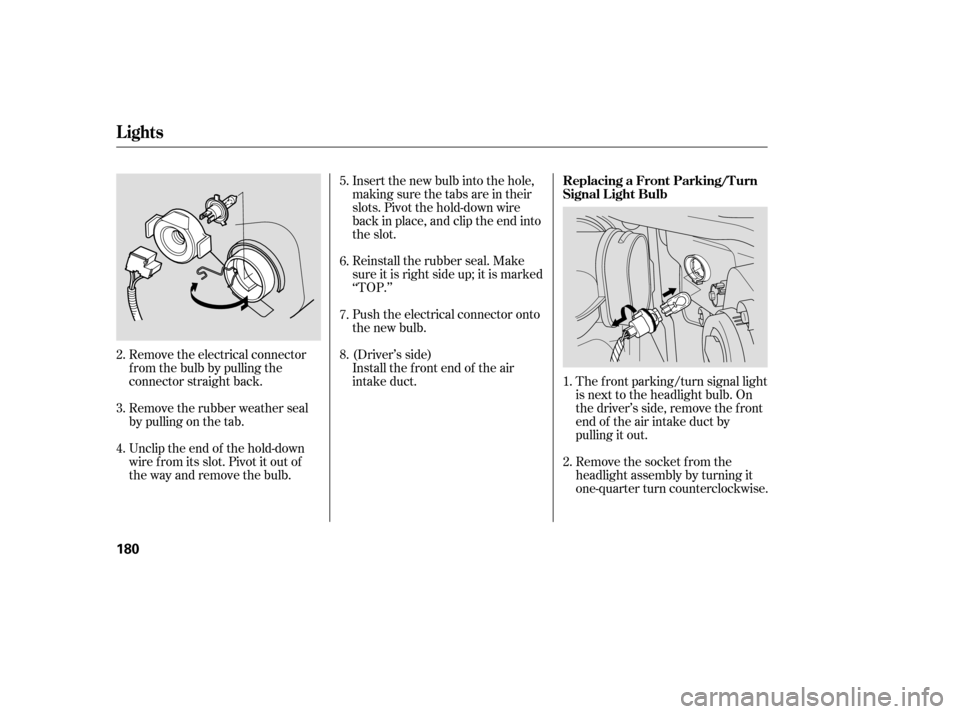
Remove the electrical connector
f rom the bulb by pulling the
connector straight back.
Remove the rubber weather seal
by pulling on the tab.
Unclip the end of the hold-down
wire f rom its slot. Pivot it out of
the way and remove the bulb.Insert the new bulb into the hole,
making sure the tabs are in their
slots. Pivot the hold-down wire
back in place, and clip the end into
the slot.
Reinstall the rubber seal. Make
sure it is right side up; it is marked
‘‘TOP.’’
The f ront parking/turn signal light
is next to the headlight bulb. On
the driver’s side, remove the f ront
end of the air intake duct by
pulling it out.
Remove the socket from the
headlight assembly by turning it
one-quarter turn counterclockwise.
Push the electrical connector onto
the new bulb.
(Driver’s side)
Install the f ront end of the air
intake duct.
1.
2.
3.
4. 5.
6.
7.
8.
2. Replacing a Front Parking/Turn
Signal Light Bulb
Lights
180
Page 183 of 249
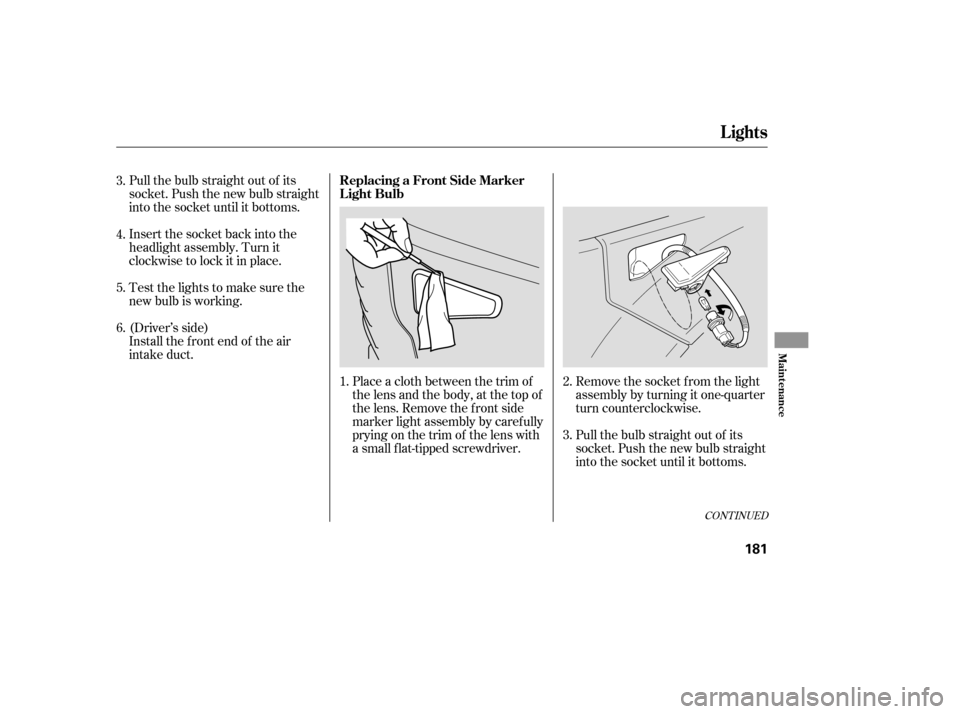
Pull the bulb straight out of its
socket. Push the new bulb straight
into the socket until it bottoms.
Insert the socket back into the
headlight assembly. Turn it
clockwise to lock it in place.
Testthelightstomakesurethe
new bulb is working.
(Driver’s side)
Install the f ront end of the air
intake duct.Place a cloth between the trim of
the lens and the body, at the top of
the lens. Remove the front side
marker light assembly by caref ully
prying on the trim of the lens with
a small f lat-tipped screwdriver.Remove the socket f rom the light
assembly by turning it one-quarter
turn counterclockwise.
Pull the bulb straight out of its
socket. Push the new bulb straight
into the socket until it bottoms.
1.
3.
4.
5.
2.
3.
6.
CONT INUED
Replacing a Front Side Marker
Light Bulb
Lights
Maint enance
181
Page 184 of 249
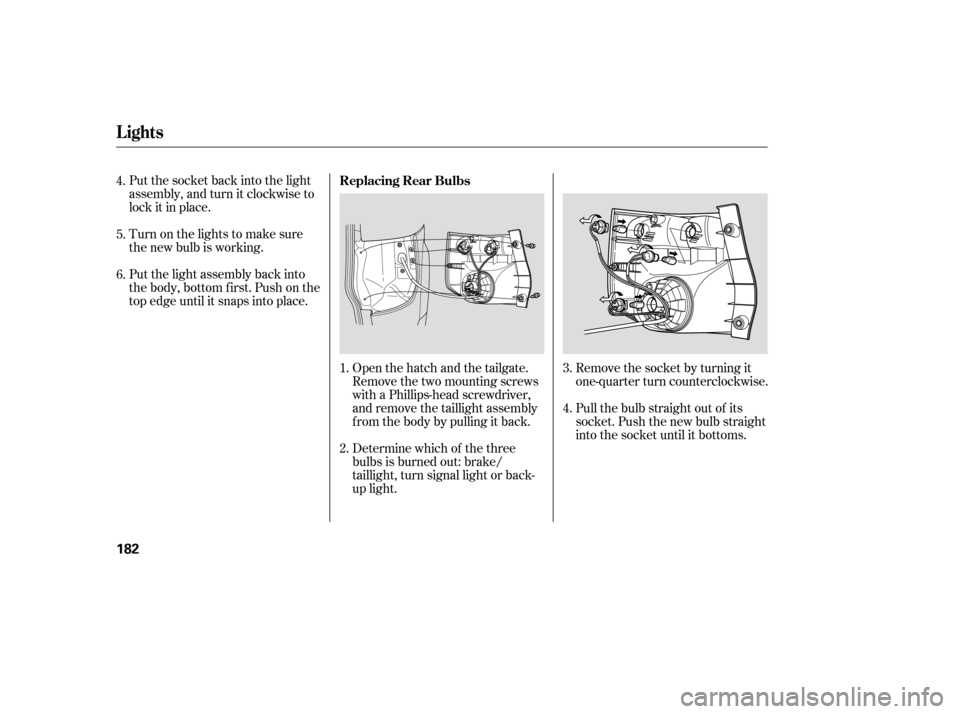
Put the socket back into the light
assembly, and turn it clockwise to
lock it in place.
Turn on the lights to make sure
the new bulb is working.
Put the light assembly back into
the body, bottom first. Push on the
top edge until it snaps into place.Open the hatch and the tailgate.
Remove the two mounting screws
with a Phillips-head screwdriver,
and remove the taillight assembly
f rom the body by pulling it back.Remove the socket by turning it
one-quarter turn counterclockwise.
Pull the bulb straight out of its
socket. Push the new bulb straight
into the socket until it bottoms.
Determine which of the three
bulbs is burned out: brake/
taillight, turn signal light or back-
up light.
1.
4.
5.
2.3.
4.
6.
Replacing Rear Bulbs
Lights
182
Page 185 of 249
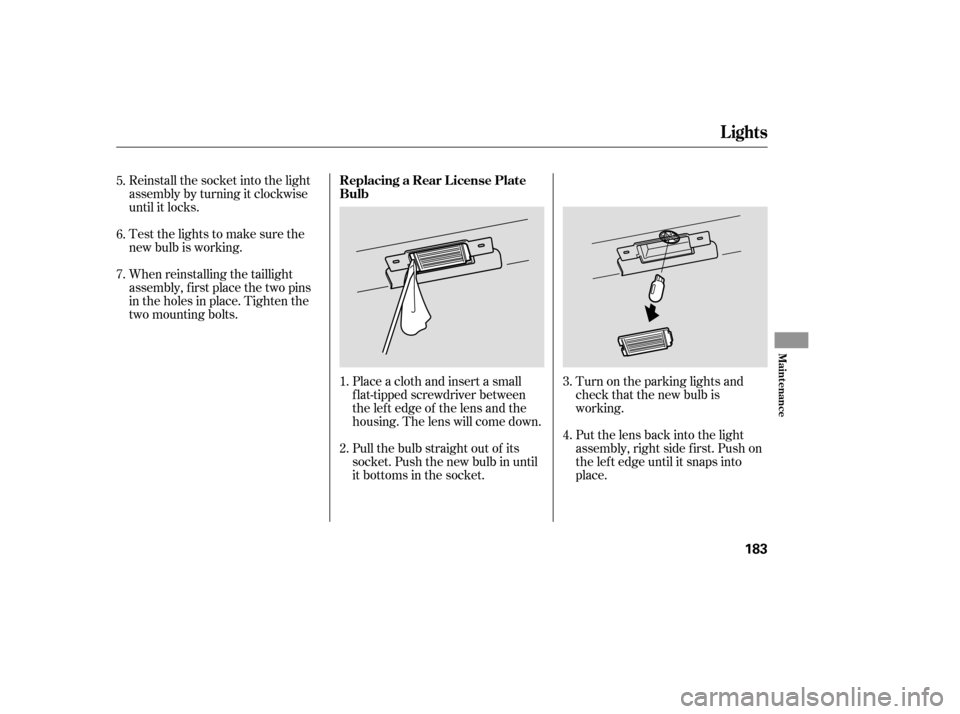
Reinstall the socket into the light
assembly by turning it clockwise
until it locks.Place a cloth and insert a small
f lat-tipped screwdriver between
the left edge of the lens and the
housing. The lens will come down.
Testthelightstomakesurethe
new bulb is working.
When reinstalling the taillight
assembly, f irst place the two pins
in the holes in place. Tighten the
two mounting bolts.
Pull the bulb straight out of its
socket. Push the new bulb in until
it bottoms in the socket.Turn on the parking lights and
check that the new bulb is
working.
Put the lens back into the light
assembly, right side f irst. Push on
the lef t edge until it snaps into
place.
1.
2.
6.
7.
3.
4.
5.
Lights
Replacing a Rear License Plate
Bulb
Maint enance
183
Page 186 of 249
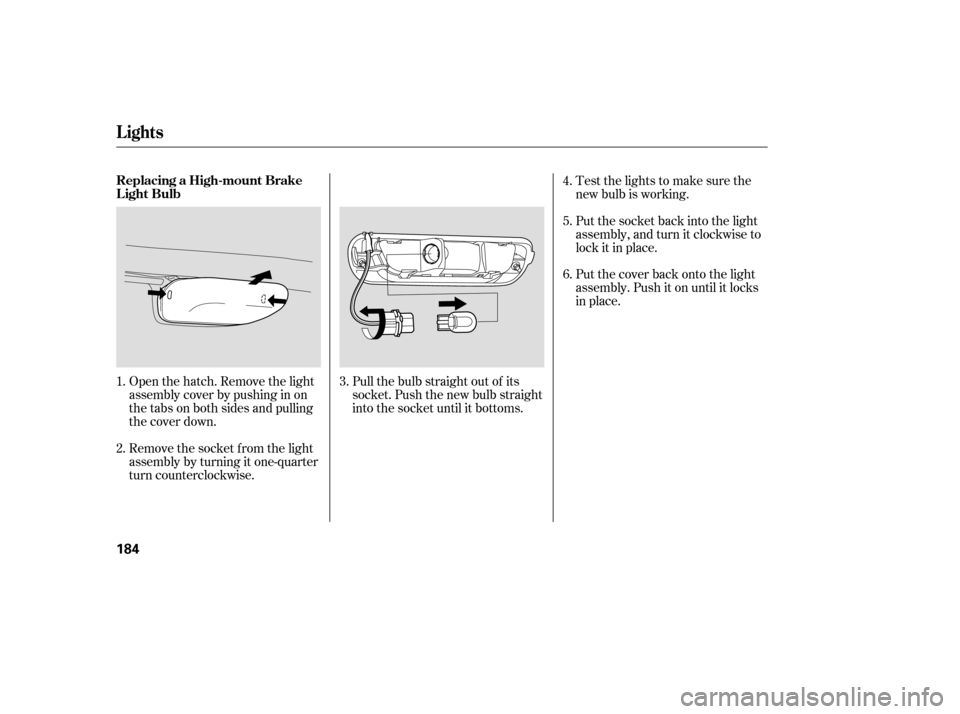
Open the hatch. Remove the light
assembly cover by pushing in on
the tabs on both sides and pulling
the cover down.
Remove the socket f rom the light
assembly by turning it one-quarter
turn counterclockwise.Pull the bulb straight out of its
socket. Push the new bulb straight
into the socket until it bottoms.Testthelightstomakesurethe
new bulb is working.
Put the socket back into the light
assembly, and turn it clockwise to
lock it in place.
Put the cover back onto the light
assembly. Push it on until it locks
in place.
1.
2. 3.4.
5.
6.
Lights
Replacing a High-mount Brake
Light Bulb
184
Page 187 of 249
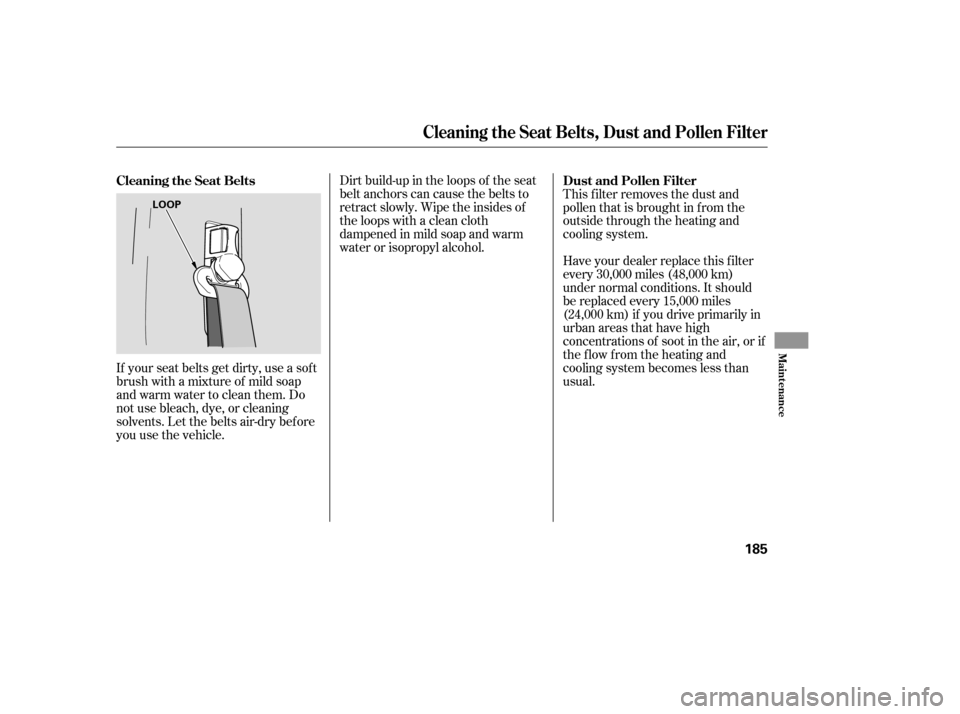
If your seat belts get dirty, use a sof t
brush with a mixture of mild soap
and warm water to clean them. Do
not use bleach, dye, or cleaning
solvents. Let the belts air-dry bef ore
you use the vehicle.Dirt build-up in the loops of the seat
belt anchors can cause the belts to
retract slowly. Wipe the insides of
the loops with a clean cloth
dampened in mild soap and warm
water or isopropyl alcohol.
This f ilter removes the dust and
pollenthatisbroughtinfromthe
outside through the heating and
cooling system.
Have your dealer replace this filter
every 30,000 miles (48,000 km)
under normal conditions. It should
be replaced every 15,000 miles
(24,000 km) if you drive primarily in
urban areas that have high
concentrations of soot in the air, or if
the f low f rom the heating and
cooling system becomes less than
usual. Dust and Pollen Filter
Cleaning the Seat Belts
Cleaning the Seat Belts, Dust and Pollen Filter
Maint enance
185
LOOP
Page 188 of 249
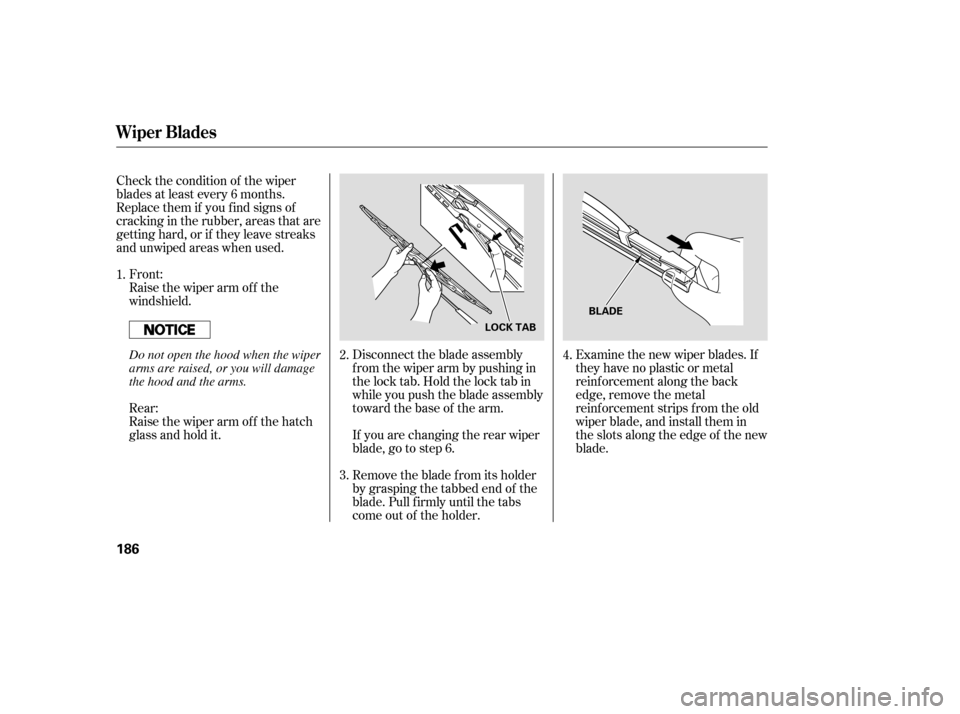
Disconnect the blade assembly
fromthewiperarmbypushingin
the lock tab. Hold the lock tab in
while you push the blade assembly
toward the base of the arm.
If you are changing the rear wiper
blade, go to step 6.
Front:
Raise the wiper arm of f the
windshield.
Remove the blade f rom its holder
by grasping the tabbed end of the
blade. Pull f irmly until the tabs
come out of the holder.Examine the new wiper blades. If
they have no plastic or metal
reinf orcement along the back
edge, remove the metal
reinf orcement strips f rom the old
wiper blade, and install them in
the slots along the edge of the new
blade.
Rear:
Raise the wiper arm of f the hatch
glass and hold it.
Check the condition of the wiper
blades at least every 6 months.
Replace them if you f ind signs of
cracking in the rubber, areas that are
getting hard, or if they leave streaks
and unwiped areas when used.
1.
3. 2.4.
Wiper Blades
186
LOCK TABBLADE
Do not open the hood when the wiper
arms are raised, or you will damage
the hood and the arms.
Page 189 of 249
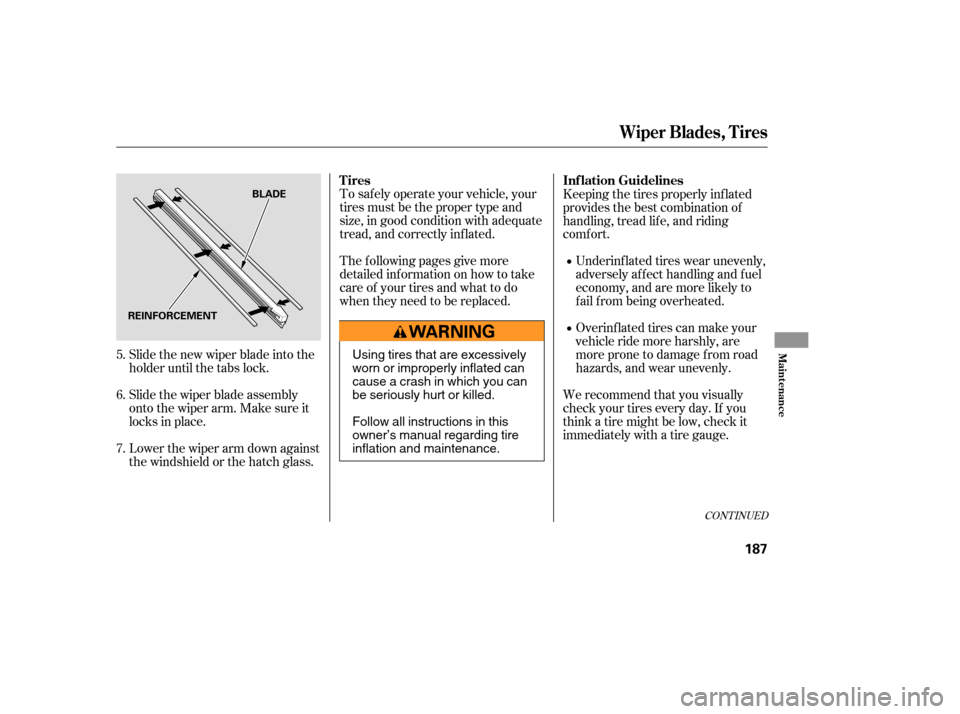
Slide the new wiper blade into the
holder until the tabs lock.
Slide the wiper blade assembly
onto the wiper arm. Make sure it
locks in place.
Lower the wiper arm down against
the windshield or the hatch glass.To saf ely operate your vehicle, your
tires must be the proper type and
size, in good condition with adequate
tread, and correctly inf lated.
The f ollowing pages give more
detailed inf ormation on how to take
care of your tires and what to do
when they need to be replaced.
Keeping the tires properly inf lated
provides the best combination of
handling, tread lif e, and riding
comf ort.
Underinf lated tires wear unevenly,
adversely affect handling and fuel
economy, and are more likely to
fail from being overheated.
Overinf lated tires can make your
vehicleridemoreharshly,are
more prone to damage f rom road
hazards, and wear unevenly.
We recommend that you visually
check your tires every day. If you
think a tire might be low, check it
immediately with a tire gauge.
5.
6.
7.
CONT INUED
T ires
Inf lation Guidelines
Wiper Blades, Tires
Maint enance
187
REINFORCEMENTBLADE
Using tires that are excessively
worn or improperly inflated can
cause a crash in which you can
be seriously hurt or killed.
Follow all instructions in this
owner’s manual regarding tire
inflation and maintenance.
Page 190 of 249

Youshouldgetyourowntire
pressure gauge and use it whenever
you check your tire pressures. This
will make it easier f or you to tell if a
pressure loss is due to a tire problem
and not due to a variation between
gauges.
Use a gauge to measure the air
pressure in each tire at least once a
month. Even tires that are in good
condition may lose 1 to 2 psi (10 to
20 kPa, 0.1 to 0.2 kgf /cm ) per
month. Remember to check the
sparetireatthesametime.
If you check air pressures when the
tires are hot (driven f or several
miles), you will see readings 4 to 6
psi (30 to 40 kPa, 0.3 to 0.4 kgf /cm )
higher than the cold readings. This
is normal. Do not let air out to match
the recommended cold air pressure.
The tire will be underinf lated.
While tubeless tires have some
ability to self -seal if they are
punctured, you should look closely
for punctures if a tire starts losing
pressure.
Check the air pressures when the
tires are cold. This means the
vehicle has been parked f or at least 3
hours, or driven less than 1 mile (1.6
km). Add or release air, if needed, to
match the recommended cold tire
pressures.
The following chart shows the
recommended cold tire pressures f or
most normal driving conditions and
speed.
Thecompactsparetirepressureis:
For convenience, the recommended
tire sizes and cold air pressures are
on a label on the driver’s doorjamb.
For additional technical information
about your tires, see page .
223
Tire Size Cold Tire Pressure
for Normal Driving
Front:
Rear:
Recommended T ire Pressures f orNormal Driving
Tires
188
60 psi (420 kPa , 4.2 kgf/cm)
P215/70R16 99S 32 psi (220 kPa ,
2.2 kgf/cm)
34 psi (235 kPa , 2.4 kgf/cm
)